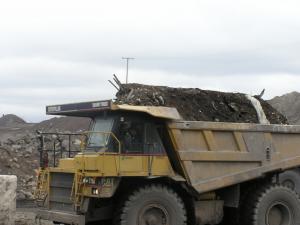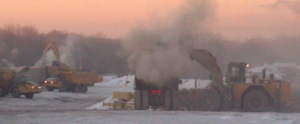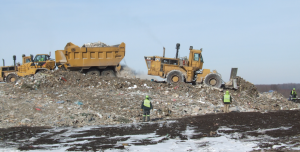A Neighborhood’s Long Struggle with an Offensive Landfill
Part II: Denial is not a River in Egypt
Demolition wastes ordinarily contain bricks, wood and drywall from razed homes, apartment complexes, commercial and medical facilities, industrial factories as well as agricultural structures such as barns and outbuildings. The average structure being demolished is over a century old and 50 years older than the EPA and any of its many chemical and product bans. Regulators often describe demolition waste as “inert”. Nothing could be further from the truth.
When Lafarge’s landfill license was granted in 2003, the Village of Lordstown sued but was steamrolled; they settled one case and dropped another. The Village has received $1.2 million in settlement fees since 2004, while Lafarge/Holcim US is allowed to pile the waste 200 feet high. The neighbors received a “complaint hotline” to a black hole.
In 2005, Ohio passed a law that gives the Trumbull County Health Department, who issues the annual landfill license and performs inspections, $.60/ton for waste disposed at Lafarge. The Health Department has received roughly $6 million in fees since 2005 but only performs one quick inspection of Lafarge every three months. It is unclear where the $6 million has gone.
Lafarge excavated the initial thirty acres fifty feet deep and exposed two groundwater tables. No liners were installed. Groundwater poured into the landfill (and still does) at a rate of approximately 40 million gallons a year.
In violation of Ohio EPA’s groundwater management regulations, pumps were installed and worked non-stop to keep the massive crater’s side-walls from collapsing from the immense groundwater pressure — until the hole was filled with waste.
The Business Grows but so do the Problems
In 2004, the initial demolition waste from New York, New Jersey and Connecticut was delivered to the landfill via CSX. Lafarge’s business plan worked well: 600 railcars of waste a month or approximately 25 curbside garbage trucks per hour proved phenomenally profitable.
However, Ohio EPA landfill regulations require demolition wastes to be spread in an “unloading zone”, then be inspected and have unacceptable wastes removed. Lordstown’s immense volume of waste renders compliance with this rule a practical impossibility. “Dump and push” is the operation’s mantra.
Lafarge conducts minimal waste inspections on either end of the train route and their customers know it. A frontline manager created a detailed environmental audit program for the out-of-state shippers but the sales group intervened and the program was dropped.
Since CSX charges their customers by the railcar, and not the ton, the customers maximize the railcar space by crushing the waste. Just think if grocery stores charged by the cart, and not by the item, how much food would be packed into everyone’s carts.
Pulverizing waste makes it visibly “unidentifiable” as to its original nature. Blending or “cocktailing” liquid chemical wastes, sewage sludges and other hazardous compounds makes them equally unidentifiable — except for the outrageous odors. Hazardous and sewage wastes are many times more expensive to legally dispose; the financial temptation is great.
As a consequence, Ohio banned pulverized and unidentifiable wastes in 2005. Lafarge has been cited for receiving pulverized waste many times through the years and most recently in October 2022. Company documents, since made public, outline how thousands of tons of New York sewage sludge, cocktailed into demolition, were disposed at Lordstown between 2010 and 2012.
Pulverized waste is wickedly horrible for many reasons besides the cocktailing problem: It creates an enormous microscopic feed stock for toxic-gas producing bacteria and the small, dry particles cause deleterious dust plumes when being handled by heavy equipment.
Toxic dust plumes contain particles of every nasty thing imaginable: asbestos within insulation, arsenic in wolmanized patio lumber, lead based paint, mercury in fluorescent lights, mold spores, fiberglass and micro-plastics; even radioactive radium paint from pre-1968 watch factories. Pre-ban contaminants like DDT and insecticides stored in barns can adhere to the microscopic particles. Some of these micro-particles can travel thousands of feet easily reaching the landfill’s neighbors.
The wastes quickly fermented in the landfill’s groundwater soup. Toxic gases, several which smell like rotten eggs, started engulfing the neighbors’ homes. The young neighbors across the street called the new “complaint hotline” and pleaded for relief. Lafarge management knew very little about waste decomposition processes and less about poisonous gases. They refused to accept responsibility and told more fables than Aesop himself.
Swamp gas from wetlands was blamed. Sewer lines, non-existent chicken farms, fertilizers on fields, gas wells and a closed landfill six miles away were blamed. But not Lafarge; they don’t cause environmental problems.
To this day neighbors gag and choke on the stench and are humiliated when friends and family visit. For two decades there has been no escape.
“We wretched from the demo stink. There are different kinds of stink: chemical, industrial. Certain days the entire landfill smelled like a urinal. No one ever stopped it", commented William Irons, retired Lafarge employee of 29 years.
To “prove” the problem was not caused by Lafarge, consultants installed a hydrogen sulfide (H2S) gas meter on the northern property boundary across from several homes. The meter also records time, temperature, wind speed and direction.
The first reports were received with joy. Hah! Wind data showed the stench was coming toward the landfill not from it. But a front line manager was not impressed; it made no sense. After some long-distance debate, corporate managers voyaged to the landfill and marched him to the meter. A field inspection determined the meter was installed upside down. Oops. Silence.
Corporate Rule #1: No matter what the facts or the law indicate, never admit guilt or direct responsibility. Plausible deniability is an art-form which requires significant management experience and guile.
56,000 railcars were unloaded from 2004 — 2011. Trucked wastes also started pouring in — but so did the complaints.
Next: Part III "Smoke and Mirrors"
Markus Aurelius
Citizens Against Lordstown Landfill
email us here
Visit us on social media:
Facebook
Legal Disclaimer:
EIN Presswire provides this news content "as is" without warranty of any kind. We do not accept any responsibility or liability for the accuracy, content, images, videos, licenses, completeness, legality, or reliability of the information contained in this article. If you have any complaints or copyright issues related to this article, kindly contact the author above.



